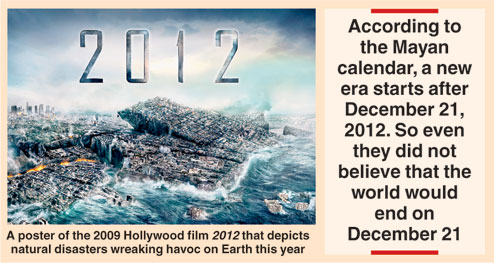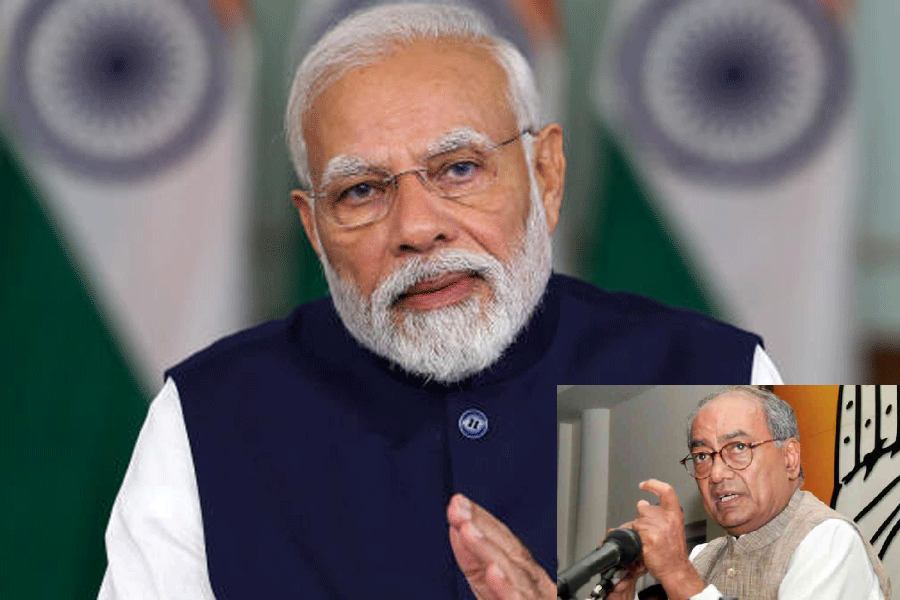 |
A rumour has spread worldwide about the end of Earth on Friday, December 21, 2012. Doomsday theories have become topics of discussion across the globe in recent weeks. India and Calcutta are not far behind. The Internet and the social networks are abuzz with interactions on how the world might end.
At the core of the rumour is the belief that December 21 is the last day in the calendar of the ancient Mayan civilisation in Latin America. Many other theories on why and how the earth is going to end on that day are in circulation. One of them predicts a devastating collision between Earth and undiscovered planet in the solar system named Niburu.
Some are saying there will be a solar maxima on December 21, when the Sun will become turbulent and emit a large amount of charged particles in the form of solar wind that will overwhelm Earth’s geomagnetic field, resulting in reversal of the polarity of the planet’s magnetic field.
Some have said a rare planetary alignment will occur around this time, causing an unprecedented tsunami or earthquake that will destroy Earth.
Another cosmic event that is being prophesied as the possible cause of doomsday on December 21 is a rare alignment of Earth, the Sun and our galactic centre that will result in a huge gravitational instability.
The prophecies have created panic and trepidation in the minds of people. Even students and educated adults have fallen prey to these stories of destruction. Scientists all over the world are busy allaying fears and telling people the truth.
December 21, 2012, is not the end of time, according to the Mayan calendar. It is rather the end of an era, which Mayans believed was of 5,125 years or 13 Bakhtuns, each Bakhtun being of a duration of a little more than 393 years.
The Bakhtuns started in 3114BC. One of them will end on December 21. After that, the Mayans believed, a new era will start. So even according to the Mayans, December 21 is not the last day on Earth.
The solar system has been extensively surveyed by astronomers using telescopes and detectors in space. Never has any object been discovered in our solar system that can be called the hypothetical planet X or Niburu.
According to scientists, if an object similar to Niburu was present, people would have already seen it in the sky with the naked eye. Moreover, its passage through the solar system would have definitely caused noticeable disturbance in the movements of other bodies in the solar system.
Solar activity has been observed to reach a maximum level every 11 years. At these times, the number of sunspots, solar storms and coronal mass ejections increase greatly. A solar storm, if violent, can cause disruptions in Earth’s geomagnetic field, interrupting satellite communication.
According to solar physicists, the solar maxima that was supposed to happen in 2011 will happen in May 2013. The solar maxima this time will not be of considerable strength, they have predicted. So no disturbances of the geomagnetic field are expected around these times.
It is to be noted that a violent solar storm cannot cause reversal of Earth’s magnetic polarity, as has been predicted by the doomsday prophets. Earth’s magnetic poles shift regularly but by a very small amount. A pole reversal is a gradual process continuing over thousands of years. It cannot happen in a day.
Once a year, Earth, the Sun and the galactic centre are aligned in a roughly straight line but that does not cause any change in the pattern of movements of either Earth around the Sun or the Sun around the galaxy. To be precise, the exact alignment happened between Earth, the Sun and the centre of the Milky Way in 1998.
Most of the planets in the solar system are going round the Sun more or less on a single plane. That is the reason why, at times, two or three planets are seen in the sky in an almost straight line. These patterns are called planetary alignments, which have happened regularly and none of them has resulted in any major earthquake or tsunami. Moreover, no such planetary alignment is happening now. So even the erroneous belief of Earth getting destroyed by such an event is misplaced.
There have been many such prophesies about the end of Earth, seemingly based on science but in reality on prejudices and biased concepts.
December 21 will be a normal day. The only specialty being that it will be the day of winter solstice, when with respect to the northern hemisphere, the Sun will be at the southernmost point in the sky and the amount of day time will be the shortest in the year. That day will not see the end of Earth and its normal passage will once again remind us of the futility and absurdness of doomsday prophecies, which only serve to stoke fear in the human mind.










